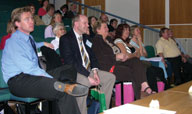 The conference was run by the Children’s Sub Group of the Vision 2020 steering group.
The conference was run by the Children’s Sub Group of the Vision 2020 steering group.
The aim of the conference was to improve services for children with low vision, by encouraging integration across professional groups and sharing good practice. It provided a chance for optometrists to interact with professionals from different disciplines and reflect on current issues affecting children’s low vision services.
Improving Service
Professor David Taylor, Professor of Paediatric Ophthalmology, Institute of Child Health, London, provided an insight into key issues in health today.
He highlighted visual pathway damage as being the major cause of visual impairment in children and recommended that research money be focused in this area. He discussed the importance of an accurate refraction in all cases and the importance of a diagnosis. It is vital that each child is treated according to their needs, not just by the syndrome that they have.
Mike Brace, chief executive of Vision 2020 UK, gave a thought-provoking lecture on social care issues. He provided examples from his personal experience, having been blinded by a firework accident at age 10. Low vision professionals should strive for social inclusion and integration of visually impaired children into society. It is important that they are taught the skills necessary to lead independent lives.
Julie Sweeting, of the SEN Advisory and Teaching Service, Oldham, explained how mainstream schools, supported by Visual Impairment Services, are well placed to meet the needs of learners with low vision. Adapted teaching styles and provision of modified curriculum material such as large print worksheets, maximise learning opportunities for children with low vision. Additional interventions should be based on identified need. Effective and inclusive schools consider the needs of learners with visual impairment in whole school bids and initiatives.
Mary Bairstow, implementation officer, provided an overview of low vision services for children in the UK. Fragmentation of services, inadequate communication and lack of multi-disciplinary working were some of the issues discussed in the Fragmented Vision report. There are still a limited number of ‘integrated’ teams. There is a need for structured multi-disciplinary low vision services, based on children’s habilitative needs.
Register now to continue reading
Thank you for visiting Optician Online. Register now to access up to 10 news and opinion articles a month.
Register
Already have an account? Sign in here
